Prolonged wearing of masks has shed light on an unfortunate side effect commonly referred to as “maskne”, writes Maha Al Akoum.
For almost all of us around the globe, wearing a mask has become a routine and essential part of everyday life since the spread of the coronavirus Covid-19.
But for some of us, like frontline healthcare workers, wearing masks all day has been a part of everyday life for a while now, even before the pandemic. While we cover up most of our face to limit the spread of Covid-19, this prolonged wearing of masks has shed light on an unfortunate side effect commonly referred to as “maskne”.
If you develop this type of breakout, rest assured you are not alone.
This type of acne is called acne mechanica and occurs due to added pressure and friction on the skin from rubbing, stretching or squeezing. Maskne or mask-related acne, appears only in areas where the mask touches the skin, different from other types of breakouts that are of hormonal origin.
Read also: Food for thought: Are your friends influencing your eating habits?
While healthy skin already contains normal amounts of bacteria and yeast, when pores get clogged due to excess sweat and humidity, these microorganisms grow excessively causing pimples or acne cysts.
Maskne can occur on its own, affecting people with otherwise healthy skin, and it can also occur as a complication of already existing acne. For people with more sensitive skin, their skin fails to get the oxygen it needs to breathe and heal. Maskne looks different depending on skin type: it can look like bumps under the skin, or even blackheads.
During the summer months, mask acne becomes particularly problematic due to excess sweat, whereby the friction of the mask in contact with sweaty, moist skin allows for the skin barrier to break down. However, and unfortunately, maskne also appears in the winter albeit through a different mechanism.
Picture perfect? How filtered images are affecting our mental health
With cold and dry air, the mask causes friction against your drier skin in the winter, which then prompts hair follicles to break open and allows acne-causing bacteria to enter the skin. This results in folliculitis, where the infection of the follicles makes them appear like pimples.
How to avoid it
While the last thing you should do is stop wearing a mask, there are a few things you can do:
- Consider changing the type of mask you wear. First and foremost, the material or fabric of the mask should always provide the adequate level of protection. Trying out a different type of fabric can help bring relief to some irritated skin. It can also help rule out any particular textile allergies, a type of allergy that is commonly underdiagnosed. Silk allergies are rare, and so if your skin is particularly sensitive, this should be a good choice for you. Dermatologists also recommend 100% cotton masks as they allow the skin to breathe and reduce rubbing and irritation.
- Be aware of the fit of the mask. Masks should be snug on the face but should also be comfortable. If masks are too tight or, alternatively, too loose and slide around your skin, this can cause pressure and/or friction and, as a result, irritate your skin. Also, when a mask doesn’t fit very well, you are more likely to use your fingers to adjust it. Touching your mask can facilitate the transfer of germs from your hands to your mask and face.
Read also: Qatar researchers create multi-sensory ‘smart mask’
- Make sure masks are clean. According to the Centers for Disease Control and Prevention (CDC), fabric face masks should be washed with hot water and soap/detergent at least daily. Detergents that are fragrance-free are ideal as leftover residue from the fragrance can also cause skin irritation. If you are using a disposable face mask, these should be thrown away after single use.
- Take a 15 minute break from your mask every 4 hours. Of course, this should only be done when and where it is safe to do so, such as outdoor open spaces, inside your car when you are alone and at home. Also make sure your hands are washed before uncovering and touching your face.
- Wash your face. This is probably the most important and most obvious way of preventing breakouts of any kind. Using a gentle cleanser can remove excess oil, sweat and bacteria from the face. Avoid cleansers that contain perfume or alcohol as these tend to cause more irritation. If your face is particularly sensitive, consult a dermatologist about the best type of cleanser for your skin.
- Moisturise. After cleansing, dermatologists recommend applying moisturiser to prevent dryness and repair the skin’s protective barrier. Moisturisers also act as a barrier themselves between your face and your mask. These moisturisers should ideally be mild and fragrance free.
- Avoid wearing makeup. Not only will makeup residue soil your mask, wearing it will also cause clogged pores and this can prolong the healing process.
Maha El Akoum, MPH, is a public health professional currently working as Head of Content at World Innovation Summit for Health [WISH].
Follow Doha News on Twitter, Instagram, Facebook and Youtube
